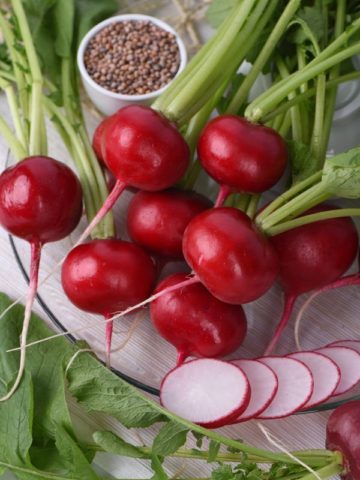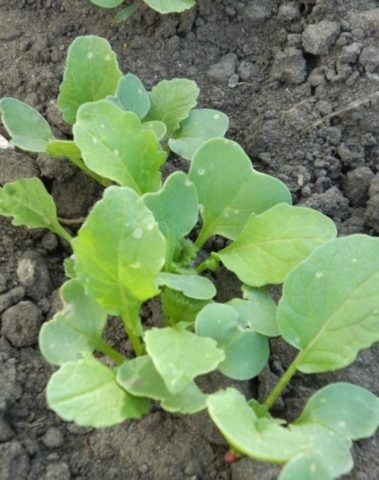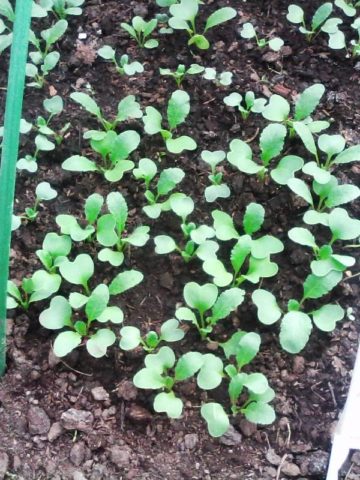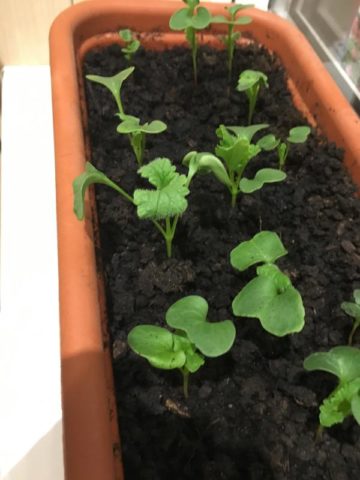Content
Experienced gardeners know how to feed radishes in order to be the first to open the fresh vegetable season. Radish is a vegetable of rapid ripening; you need to carefully monitor the growth phase. Fertilizers for radishes are applied in strict compliance with the terms and consumption rates. Otherwise, the fruits will be empty, rough, bitter.
Do I need to feed radishes
The culture prefers slightly acidic or neutral light soils. If the balance is disturbed in one direction or another, the soil must be enriched before sowing. Radish needs nutrition, which is grown in the open field and in the greenhouse, at the planting stage and during the period of active growth.
When do radishes need feeding?
If the site for planting radishes was prepared in the fall, in the spring the soil does not need to be enriched. It is easy to determine the type of fertilizer that radish needs especially badly by the appearance of the plant:
- too pale color of the tops, its lifelessness, indicates a lack of nitrogen in the soil;
- a massive vegetative part and small fruits indicate an excess of nitrogen and a need for phosphorus.
Subject to the rules of crop rotation and growing on rich soils in a moderately rainy season, there is no need to feed radishes in the spring.
When to fertilize radishes
The ideal option for fertilizing the soil for radishes is applying top dressing to the site in the fall. The bed is dug up and the nutrient mixture is added to the ground.
The first feeding is carried out at the time of sowing the seeds. For this, the fertilizer is spread directly to the bottom of the furrow or the sowing is soaked in a nutrient solution for 12 hours. The second top dressing is carried out during the active growing season of seedlings 10-12 days after sowing at the stage of appearance of 2-3 leaves. If the soil is sandy-clayey and very poor, the radish is fertilized twice during the period of active growth - 4-6 and 15 days after sowing.
Fertilizers for radish
Each farmer independently chooses what type of fertilizer to feed the early radish. Gardeners living in the countryside prefer natural fertilizers. City dwellers are accustomed to feeding garden crops with ready-made agronomic mixtures.
The following types of fertilizers are available to any gardener:
- organic - humus, chicken, rabbit droppings;
- mineral - urea, ammonium nitrate, superphosphate;
- herbal infusions from fresh grass hay.
A separate category is represented by wood ash - a natural mineral fertilizer rich in nitrogen. It is prohibited to pour ash into excessively alkaline soils.
By the type of fertilization, mixtures are distinguished:
- for root top dressing through soil application;
- for vegetative feeding by spraying the leaves.
How to fertilize radishes during planting
The best natural fertilizer for radishes in spring is a thin layer of ash at the bottom of the seed furrow. Experienced gardeners use another proven method.
For 1 sq. m of land will be needed:
- 10 g of urea;
- 40 g double superphosphate;
- 1 glass of wood ash;
- 5 kg of humus or compost.
Fertilizer is applied as follows:
- Determine the bed for planting.
- Dig the area to a depth of 20 cm.
- Spread the mixture evenly.
- Sprinkle on top with a layer of soil.
Seeds are sown immediately after adding the mixture to the soil, watered and compacted to retain moisture.
To wake up the seeds, it is customary to soak them in growth stimulants for 12 hours. It can be Novofert, Regoplan, Potassium humate, Epin.
How to feed radishes in spring during active growth
There are several proven recipes for radish dressing. The choice of the type of fertilizer is carried out in accordance with the age of the plant and the qualitative composition of the soil.
How to feed radishes after germination
The first shoots of radish appear 4-5 days after sowing. During this period, the sprout begins to actively absorb fertilizers by the root system and accumulate nitrates in the fruits. It is optimal to introduce organic fertilizers these days. Nutrient mixtures are applied during the next watering at the root, preferably in the evening.
There are several chicken manure-based recipes that have been proven by gardeners:
- A liter jar of droppings is bred in 2 buckets of water, infused for 10-12 hours.
- 1 bucket of manure is poured with 3 buckets of water and mixed, the concentrate is again diluted with water in a ratio of 1: 4.
- 1 bucket of litter is bred with 3 buckets of water, insisted for 3 days, add 4 tbsp. spoons of "Baikal".
Chicken droppings are replaced with rabbit droppings and bred in the same proportions. The droppings of small animals contain all the necessary substances to obtain a juicy tasty radish. The prepared mixtures contain phosphorus, nitrogen, potassium, magnesium.
An alternative to the litter will be the foliar feeding of the radish with “Aydar” or the fertilizing of the radish with urea through spraying. Ready mix recipe - 1 liter of fertilizer per 10 liters of water. The solution is used exclusively for foliar feeding during the growing season.
How to fertilize radishes in spring for a better harvest
Excessive growth of leaves and small roots indicate a lack of potassium and phosphorus. The following composition will help to correct the situation:
- 40 g superphosphate;
- 20 g sulfuric acid;
- 1 glass of ash.
Top dressing is carried out as follows:
- Dry ingredients are mixed in a separate container.
- Dilute the powder in 10 liters of warm water.
- Mix the solution thoroughly and leave for 20-25 minutes.
- Water the aisles, avoiding contact with the leaves.
How to feed radishes for fast growth
A delay in the growth of tops indicates a nitrogen deficiency. Replenishing it is easy enough with urea. The nutritional composition is prepared just before use. To prepare the solution, 1 matchbox of urea is diluted in 1 bucket of warm water. Deciduous rosettes are sprayed or watered between rows.
Features of feeding radish in the open field and in the greenhouse
Beds with early spring, summer and autumn plantings in the open field are fertilized according to the same principle. The introduction of nutrient formulations during autumn digging is considered preferable. Mandatory seed stimulation is carried out before sowing. Top dressing during the growth period is carried out taking into account the fertility of the soil, observing the appearance of the leaves. Leaf spraying of radish for the purpose of fertilizing is carried out in the early morning or late evening, when the sun is on the horizon. Watering with a nutrient composition is carried out in the aisles, and not on a deciduous outlet.
The ripe crop in the greenhouse is harvested throughout the year.The soil in the greenhouse is enriched with mineral and organic fertilizers. If radishes are sown in a greenhouse in rich soil mixtures, dusting with ash during the period of appearance of the first leaves is sufficient.
Traditional methods of fertilizing radish
Industrial mineral fertilizers for radishes are not recognized by all gardeners. Many people use natural infusions of rotting weed pests or medicinal herbs. Such formulations have a number of advantages:
- ecological cleanliness and safety for the soil;
- accelerated absorption by cultivated plants;
- rich mineral composition.
For the preparation of folk remedies for feeding vegetables, improvised means are used, so material costs are minimal.
Among gardeners, infusions from freshly picked nettles have become the most popular. Composition recipe:
- Prepare a large container, such as a garden barrel.
- Fill it 2/3 with chopped nettle.
- Poured over with warm water and exposed to the sun.
- Insist 7-10 days, stir daily.
The finished concentrate is diluted at the rate of 1 liter of green slurry for 10 liters of water for inter-row irrigation, and 1 liter of slurry for 20 liters of water for foliar spraying.
A solution based on a multicomponent powder from garden herbs - comfrey, colza, tansy, horsetail and chamomile - has proven itself well. The nutritional composition of this infusion is rich in potassium, nitrogen, calcium and phosphorus. The solution is prepared according to the identical recipe from nettle.
Many gardeners experiment and enrich the composition with onion peels, garlic arrows, chicken droppings. These ingredients must be added with care so as not to burn the vegetative part of the cultivated plant when watering and spraying.
Conclusion
To feed the radish in time is the task of any zealous gardener. Fruits after timely application are tasty, juicy, there is no bitterness and emptiness in them. When applying fertilizers, you should follow simple rules:
- Nitrogen is introduced during the growing season, potassium-phosphorus composition at the time of fruit formation.
- Concentrates must be diluted with water to avoid scalding the deciduous rosette.
- The solutions are introduced into the aisles so as not to inhibit the growth of root hairs.
The type and composition of the fertilizer is selected according to the situation, observing the course and growth phase.














